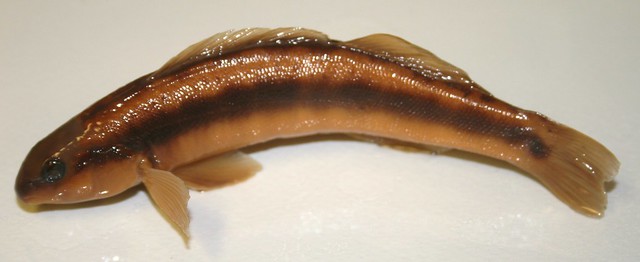Percina aurantiaca Cladus: Eukaryota Name Percina aurantiaca (Cope 1868) References * Percina aurantiaca Report on ITIS Vernacular names Distribution The tangerine Darter, also known as the river slick, is found throughout mountainous regions of the upper Tennessee River drainage. In the Southern Appalachian Mountains. It resides in smaller rivers and is most common in the Emory, Hiwassee, Little river, Little Pigeon, and Tellico rivers. It is found in east Tennessee, northern Georgia, and western North Carolina, and Virginia. In Georgia and North Carolina it is listed as a historic species in need of management. The habitat needs of the Tangerine darter are: it needs clear and cool creeks or small rivers. In these rivers it likes areas that have large boulders, bedrock and a gravel substrate. It also likes to swim in the deeper riffles of these rivers. In winter the tangerine moves to deeper pools. The tangerine darter spawns in shallow sandy gravel riffles that have consistent flowing water. The river slick is a late spring to summer spawner, breeding season begins in May and runs through July. It is triggered by water temperature. Spawning occurs at about 3–4 years of age, although sexual maturity comes much earlier for tangerine darters with males reaching sexual maturity at 1 year of age and females 2 years of age. The life span of the tangerine darter is about 4 years. Tangerine darters spawn by first the male mounting the female; the female then scatters her eggs over the gravel, while the male disperses milt and fertilizes the eggs. While doing this both the male and female make a quivering motion. Females choose the most brightly colored males, (bright orange black line with some blue where orange meets the black). Males also become territorial during mating season and will defend their spawning riffles. Females lay in between 120 and 1,100 eggs. The tangerine darter does not care for its eggs. Juvenile tangerine darters are found in calmer water and grow to between 2 and 3 inches in their first year of growth. The Tangerine Darter is an insectivorous fish. As a juvenile they feed primarily on mayflies and midges and adults feed on mayflies and caddis flies. Tangerine Darters get their food by searching through the aquatic vegetation and eating the aquatic insects off of the plants. Adults are also big enough to roll small gravel and search for prey that way. Although the tangerine darter is not a game species it is sometimes caught by fly fishermen using mayfly and caddisfly patterns. As with all other organisms the biggest threat to the tangerine darter is habitat degradation. This is due to point, and nonpoint pollution, erosion, sedimentation. Erosion the number one cause of habitat degradation can be limited by loggers, construction workers, and other laborers using Best Management Practices. An example of tangerine darter decline and then comeback would be on the Pigeon River of East Tennessee. In 1908 Champion International built a paper mill on the little pigeon river and decimated many of the native fish. In the 1980s the mill cleaned up its refuse and the river is in steadily getting better. Tangerine darters have been successfully reintroduced back into the pigeon river downstream of the paper mill. The Tangerine darter can be raised and successfully reproduce in captivity. This will be extremely important in the future management of the tangerine darter as well as most other threatened darter species. It is important to keep our rivers and streams clear of erosion and pollution. Some ways you can help at home are to not drive your vehicles through creeks and small rivers and never use a creek or stream as a road. Keep a buffer of native vegetation next to a stream. If you have a farm; fence livestock out of rivers and streams, or only allow livestock in one part of the river or stream. As far as professional management goes, first the tangerine darter needs to be monitored by fisheries professionals. This would best be done by seining and electro shocking, to get data on how many are out there. This can then be compared to past data. In the streams where it is in decline these can be monitored and managed. If there is nonpoint pollution the source of this would need to be found and limited or eliminated. Chadwick D. 2010. "Silent Stream." National Geographic Vol 217 Issue 4 116-128. Etnier D. 1993 "The Fishes of Tennessee" University of Tennessee Press. Greenberg L. 1993. "A descriptive and experimental study of microhabitat use by young of the year benthic stream fishes" Ecology of Freshwater Fish. Phillips C. 2007. "Captive Propagation of Tangerine Darters for Re-introduction in the Pigeon River, Tennessee" Master's thesis University of Tennessee Shceffler P. 2007 Request for Section 26a approval for Pedestrian Bridge at Seven Islands Wildlife refuge" Watson B. 2006 "Tangerine Darter" North Carolina Wildlife Profiles http://conservationfisheries.org/
Source: Wikipedia, Wikispecies: All text is available under the terms of the GNU Free Documentation License |
|

